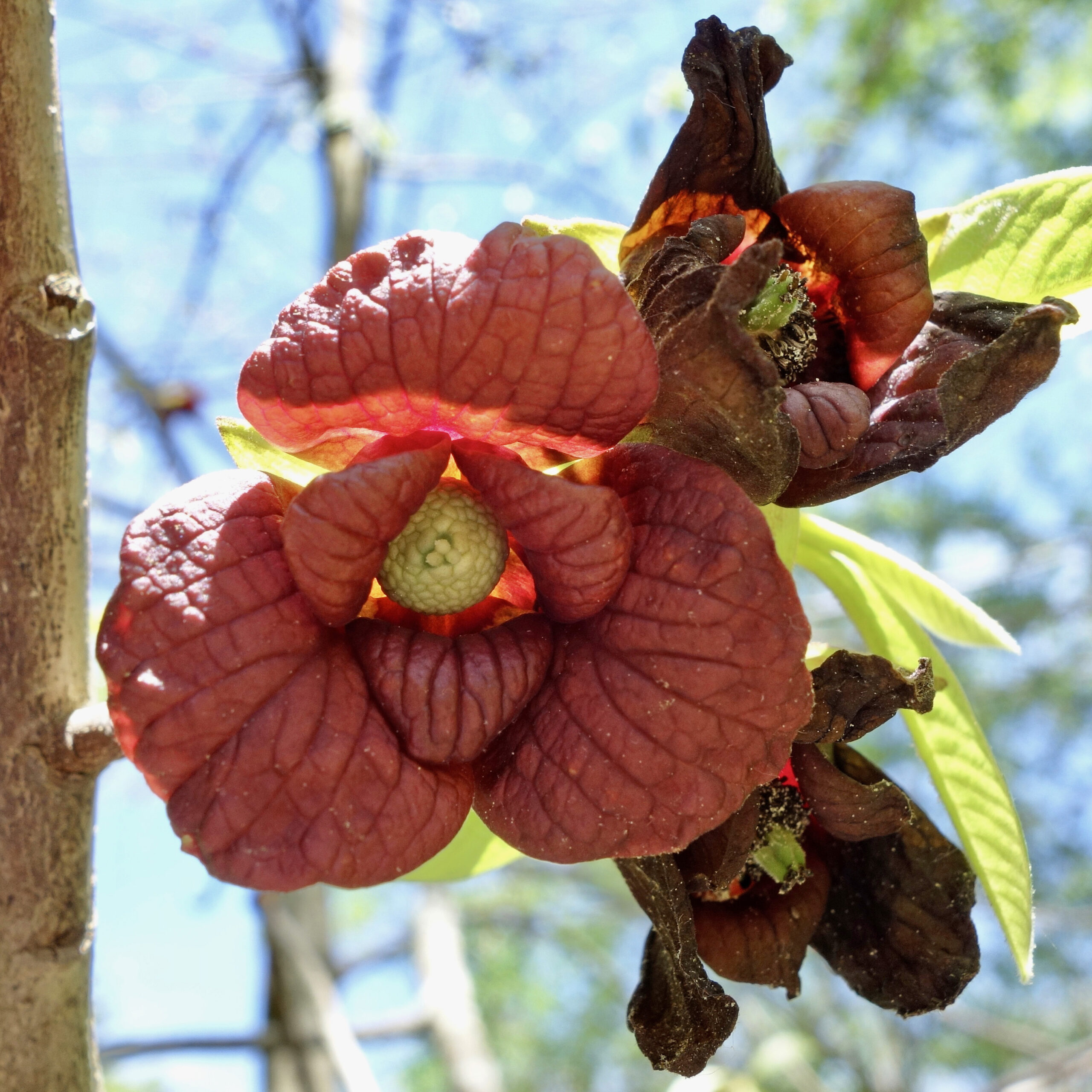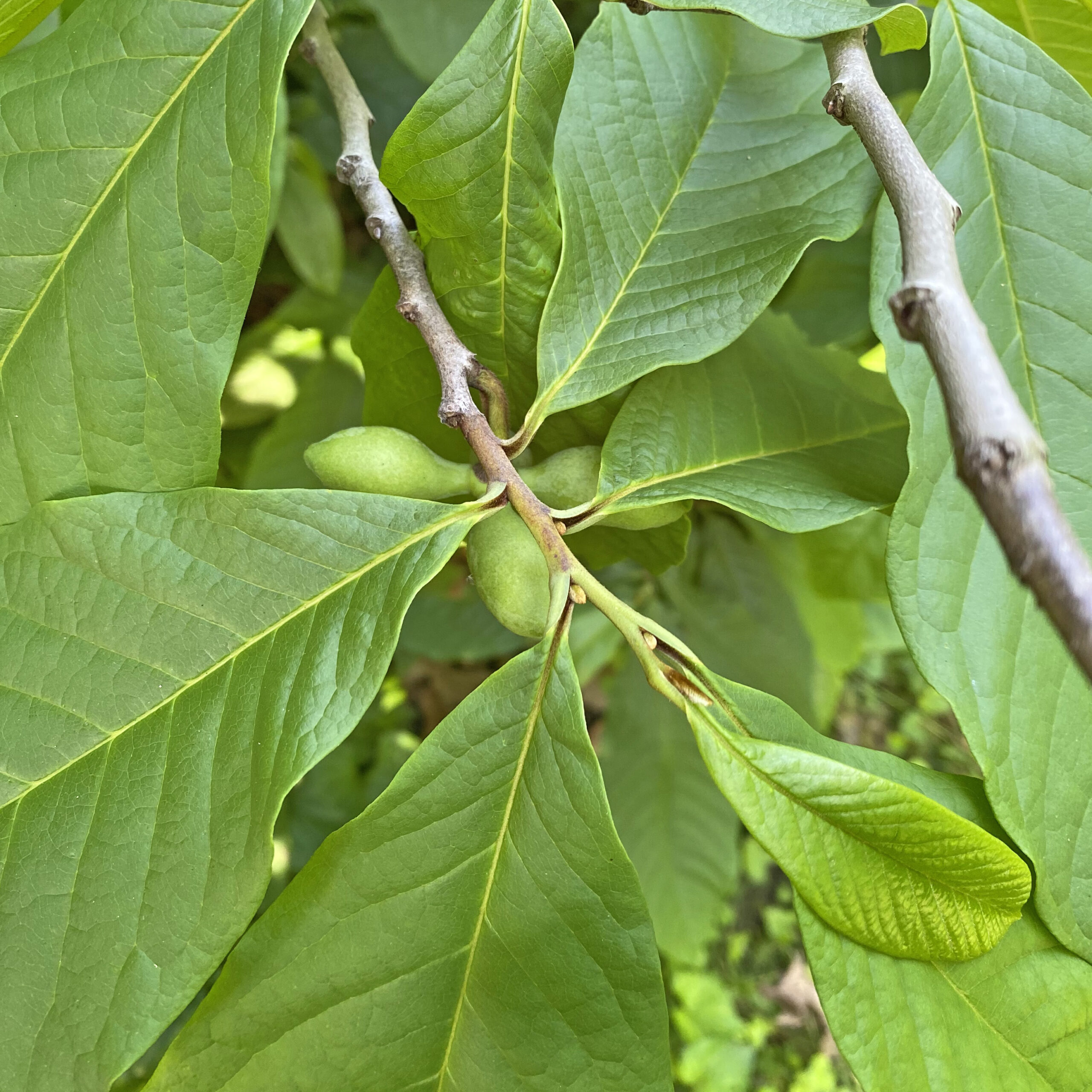The modern life and growing appeal of a tree that fed mammoths and mastadons
The Arnold Arboretum grows remarkable plants from around the world, yet some of the most obscure and intriguing species may be hiding in our own backyards. To my mind, the American paw paw (Asimina triloba) stands as a prime example, largely unavailable in the trade yet notable among native tree enthusiasts for its delicious fruit, interesting reproductive biology, and disrupted history of co-evolution. Native to the Eastern and Midwestern United States and Canada, paw paw belongs to the Annonaceae—commonly (and descriptively) known as the custard apple or soursop family—and is the only member of this otherwise tropical and subtropical group that can grow outdoors at the Arnold Arboretum.
In cultivation, paw paw grows as a small understory tree or large shrub. In the wild, it grows in shady areas with rich, moist soil, often along the edges of flood plains. A clonal plant, Asimina sends out root suckers that sprout and create genetically identical thickets. Each trunk can grow to twelve inches in diameter and thirty-five feet in height. It bears large leaves up to a foot in length and five inches in width. The leaves are simple, alternate, and spirally arranged, a tropical appearance shared by other members of its family that offers unique appeal to gardens in our temperate environment.


Asimina triloba blooms in early spring as its leaves are beginning to emerge. The 2-inch-wide flowers are reddish purple, and each contains both stamens (pollen-producing structures) and a carpel (ovule-bearing structures). Despite the androgyny of its flowers it does not self-pollinate. The deep, flesh-like tone of the flowers attracts carrion-feeding insects like flies and beetles, which distribute its pollen to other genetically distinct trees. Without pollen from a different plant, the paw paw will not produce fruit.



In late June I observed several fruits (technically berries, because they form from a single fruit with a single ovary with multiple seeds) developing on Arboretum accession 1222-79*A on Peters Hill. These berries may grow to a length of about six inches and weigh a whopping eighteen ounces each, making them the largest edible fruits of any native plant in the continental United States. Outside of the wild, berries are typically half this size and form individually or in clusters of two to five. They emerge green, becoming mottled with yellow and brown as they mature, though coloring does not necessarily signify ripeness. In fall, fruits drop and ripen on the ground while the leaves turn a vibrant golden yellow. The scent of ripening fruit attracts ground dwelling animals to eat the berries and disperse their seeds.




The flavor of paw paw lies somewhere between a mango and a banana. This gives rise to a number of regional names for the tree, like Appalachian banana and dog banana. When ripe, the flesh is a creamy, rich yellow with a smooth, custardy texture. The fruit will give slightly when squeezed and emits a sweet smell, like a mango when it is ready to eat.* The seeds are large (½ inch to one inch in length), bean-like in shape, dark in color, and evenly dispersed through the flesh. The pawpaw has been consumed by humans on our continent for thousands of years, however it has not been successful as an agricultural crop due to its brief shelf life. Some cultivated varieties of paw paw are available commercially as seeds and plants in some specialty nurseries. As a child, I planted three paw paw saplings in our garden with my botanist father and had the pleasure of eating many sweet fruits from those trees.
Humans aren’t the first to enjoy its tasty fruits. The fruits of Asimina are called anachronistic, as they are thought to have co-evolved with now-extinct megafauna like mastodons, mammoths, and giant ground sloths that once roamed North America. These animals would have consumed the large seeds with the berry flesh and distributed them whole in their dung as they migrated throughout the continent. In the wake of these extinctions, the paw paw’s natural range fragmented into isolated populations in the South and Midwest; such isolation is another characteristic of anachronistic plants. Paw paw has survived without its co-evolutionary animal partners through clonal reproduction, human distribution, and cultivation. Other native trees considered anachronistic at the Arboretum include the Kentucky coffee tree (Gymnocladus dioicus), honey locust (Gleditsia tricanthos), American persimmon (Diospyros virginiana), and Osage orange (Maclura pomifera).
* Please note that picking any fruits or flowers from plants in the Arnold Arboretum is strictly forbidden. However, plant parts that have fallen to the ground are fair game for closer study.
Explore our Collections
Currently nine specimens of Asimina triloba grow at the Arnold Arboretum. I invite you to visit each of our accessioned plants to learn more about this fascinating tree up close. Here are some details about our paw paws to aid your explorations (accession numbers below retrieve the plant in our online collections database and mapping application, Arnold Arboretum Explorer):
- Planted in the hickory collection near the Centre Street entrance, paw paw 12708*A grows under the canopy of a Hubei wingnut and pecan tree and is the oldest accessioned individual of the species in the collection. It was grown from seeds collected by E. J. Cole of Grand Rapids, Michigan in 1903, and has grown in its current location since at least 1926.
- 1222-79*A was collected in Missouri by staff collectors Gary Koller and Jack Alexander and accessioned in January 1980. Planted in 1986 on Peters Hill, it grows as a large clump, highlighting the species’ clonal growth.
- Also located on Peters Hill are 205-91*A, collected in Ontario by Guelph Arboretum and accessioned in April 1991, and 143-94*B collected in Michigan by Timothy Boland and accessioned in March 1994. These specimens derive from populations that are genetically distinct from one another and therefore may cross pollinate and bear fruit.
- Accessions 252-2013*A and 252-2013*B were collected in Illinois by Michael Dosmann and Jonathan Damery and accessioned in October 2013. Accession 540-2017*A planted near the Centre Street Gate and accessions 540-2017*B and 540-2017*C planted at Weld Hill were collected in Iowa by Andrew Schmitz and accessioned in November 2017.

